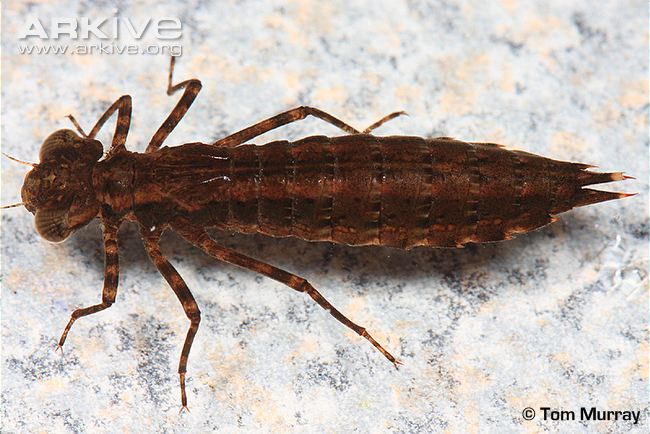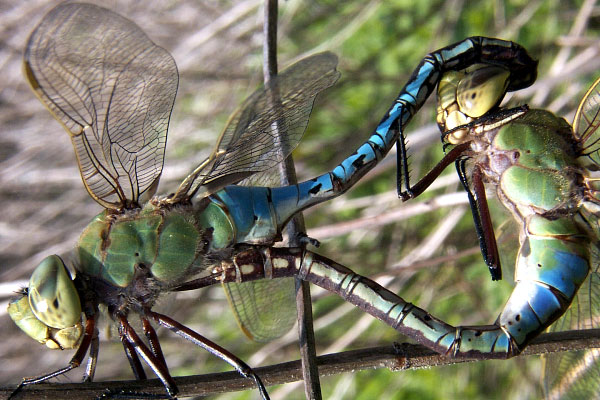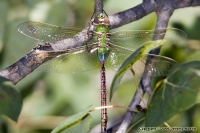The dragonfly starts its life as an egg, usually deposited in the fall in wet plant stems. After the eggs hatch, the larval form (or nymphs) will grow in size underwater, shedding their skin 10-12 times. When the dragonfly is ready for final emergence (watch this fantastic video), it will crawl out of the water, attach itself to a secure spot above the water's surface and hatch out of its final larval skin. It will stay in this spot for at least a half hour, pumping hemolymph into its wings to enlarge and straighten them. After the wings dry, the young teneral will be able to weakly fly and will then spend the next three weeks of its life, eating, gaining strength and sprucing itself up for mating.
 Once the dragonfly has reached sexual maturity, it will spend its time looking for a mate. When a male has found a female, he will grab the female thorax with his hind legs and arch his back to grab her head with specialized claspers (creating a "tandem"). The female then swings her abdomen around grabbing the male's secondary genitalia and creates "a wheel" (shown below) while mating. This method is unique in the insect world.
Once the dragonfly has reached sexual maturity, it will spend its time looking for a mate. When a male has found a female, he will grab the female thorax with his hind legs and arch his back to grab her head with specialized claspers (creating a "tandem"). The female then swings her abdomen around grabbing the male's secondary genitalia and creates "a wheel" (shown below) while mating. This method is unique in the insect world.
There are approximately 115 dragonfly species in Wisconsin which can be found in nearly any habitat with water and a food source. Dragonflies are harmless to humans, but do a fantastic job of controlling insect populations with their carnivorous habit and voracious appetite. Both the naid or nymph (left) and adult dragonfly will mainly feed on other insects and can eat up to their body weight in a 30 minute period. Nymphs will also eat small fish and other aquatic invertebrates if hungry enough however.
 Wisconsin Green Darners are particularly interesting. Fifty of the world's 5,200 dragonfly species migrate. It has been theorized that they migrate to increase the number of successful dragonflies produced each season, since migrating dragonflies can arrive and start reproducing long before resident nymph populations have even emerged from frozen ponds. Wisconsin actually has both a resident and a migrating population of Green Darner. The migrating species arrives early in the spring, already in its adult form, from the south. They will mate, lay eggs and die during the summer, and because their eggs are laid so much earlier than the resident population, their descendants can go from egg to adult while still on the summer grounds. After a long summer, the non-resident population of adults will head south to begin their migration. They migrate much like a bird, taking advantage of tail winds, using some days to travel and other days to rest. The average daily flight of a Green Darner during migration is 7.5 miles, but they have been documented to fly up to 100 miles in a day. Their total length of migration is still being studied. An adult dragonfly will only live for a month or two.
Wisconsin Green Darners are particularly interesting. Fifty of the world's 5,200 dragonfly species migrate. It has been theorized that they migrate to increase the number of successful dragonflies produced each season, since migrating dragonflies can arrive and start reproducing long before resident nymph populations have even emerged from frozen ponds. Wisconsin actually has both a resident and a migrating population of Green Darner. The migrating species arrives early in the spring, already in its adult form, from the south. They will mate, lay eggs and die during the summer, and because their eggs are laid so much earlier than the resident population, their descendants can go from egg to adult while still on the summer grounds. After a long summer, the non-resident population of adults will head south to begin their migration. They migrate much like a bird, taking advantage of tail winds, using some days to travel and other days to rest. The average daily flight of a Green Darner during migration is 7.5 miles, but they have been documented to fly up to 100 miles in a day. Their total length of migration is still being studied. An adult dragonfly will only live for a month or two.
Fun Facts:
- The Globe Skimmer has the longest known migration of any dragonfly species. Their migration travels from Maldives to Africa and back again clocking in at nearly 11,000 miles!
- Dragonflies are great at controlling mosquito populations!
- Dragonflies are ancient animals. Fossil records show dragonflies from 230 million years ago with wingspans of nearly 30 inches across. That's nearly 2 and a half feet!
- Dragonflies are incredibly fast. Dragonflies can travel at speeds of up to 36 mph. To put this into perspective, the world's fastest human can only travel at 35 mph and only for a very brief period of time.
- It is thought that the Green Darner gets its name because of its resemblance to a darning needle. People used to believe they were the devil's helpers and could sew shut the mouths of humans.





